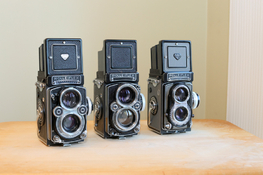Maybe @koraks can help here?
Not sure...I'd have to have the device here. But in general, there are a couple of ways to solder SMD IC's onto PCB's:
* Reflow oven. Really only works for flat, rigid PCB's and mostly for new assemblies.
* Reflow hot plate. Pretty much as above. I sometimes to rework on PCB's using the hot plate if it's a lot or cannot be done otherwise (e.g. alu-core PCB's), but for flex type PC'B's, not really a viable option, I suspect.
* Hot air soldering station. Should work. First clean the contacts on the (flex) PCB with a soldering iron and a fine tip and some flux. Make sure each pad has a nice little shiny bead on it and no pointy 'whiskers' sticking up (use more flux). Then tack the IC in place with some flux; the stickiness of the flux will mostly keep it in place. Press down lightly with tweezers etc. and then blast the IC with the hot air gun. The temperature setting is a bit of a gamble, but I like to set it pretty hot so it doesn't take much time. I figure it's better to only have to blast it for a few seconds at high heat vs. holding it at a high temperature for up to several minutes. Btw, I've maltreated IC's by heating them to ridiculous levels (even with a small butane torch!) and have never destroyed one. The worst I managed was to get the glass filter unstuck from an SMD photodiode, but that's really an outlier case.
* Plain old soldering iron. Use a small tip. Clean pads as above, and tin them a little if there's no tin (anymore) on them. Apply flux on/around the pads, stick down the IC and hold it down with tweezers. Then tack two pins in opposite direction with the soldering iron, one at a time. This should hold the IC in place as you solder the other pins, pressing gently down on them with the soldering iron and allowing the tin to flow between the pad and the pin. Do this one by one. On IC's with a very small pitch, you may end up fusing several pins together especially if you've used quite a bit of tin. Don't worry about it and just suck up the excess using some solder wick.
The advantage of the soldering iron approach is that you only heat the assembly very locally and very briefly (at least after a bit of practice). The drawback is that you usually bend down the pins of the IC very slightly as you press them through the tin ball on the pad, which is not necessarily a problem, but it sometimes leaves a pin 'hovering'. Be sure to inspect each pin carefully with a good loupe, microscope or magnifier, and do a continuity test between each pin and its pad. Don't press down the test leads strongly when doing the continuity test, as you'll get a false positive by temporarily pressing the pin down onto the pad, making it seem that there's good contact, while there really isn't anymore once you release the test lead from the pin.
Use flux-core lead solder, and no lead-free. Lead free is there to meet environmental regulations, but literally everyone who has done any soldering will confirm it's far easier to work with leaded solder. So unless you have to meet RoHS regulations (e.g. you do commercial repairs), do yourself a favor and just use old-fashioned 67/33 SnPb solder. The flux core is very important. I like 0.75mm diameter solder, which is a good general purpose for relatively fine work.
Use a temp. controlled soldering iron. They're cheap if you don't insist on getting e.g. a Weller. The 'Hakko'-ripoff Chinese units tend to work just fine. For practice, pick up any old piece of junkyard electronics and solder everything off of it and then back onto it. For desoldering SMD parts, using a hot air station is pretty much the only practical way. Again, the Chinese-made units are cheap and work fine.
Use a decent, modern flux, and no resin. Resin works very well as a flux, but the remnants cannot be cleaned up (they're harmless, but it looks ugly) and with rework it tends to carbonize. Modern, colorless flux, either the paste or the liquid kind, can be cleaned with IPA/ethanol or even soapy water (dry well). Don't believe "no-clean flux". There's no such thing. But that's OK because some ethanol or IPA and a brush cost virtually nothing.
SMD soldering seems daunting at first, but it really isn't. Things get challenging with QFN packages that have no leads, but even these can successfully soldered at home (I've done so many times). The only thing I personally won't touch, is BGA (ball grid array). Theoretically, I could do it with the hot air gun and the hot plate, but really, I don't bother and instead just select regular SMD and if needs be QFN components. In cameras, I think BGA packages only appeared some 15 years ago or so, so when working on film cameras, don't worry about this, or QFN, which was also not yet around the corner in the 1990s.






 .
.

